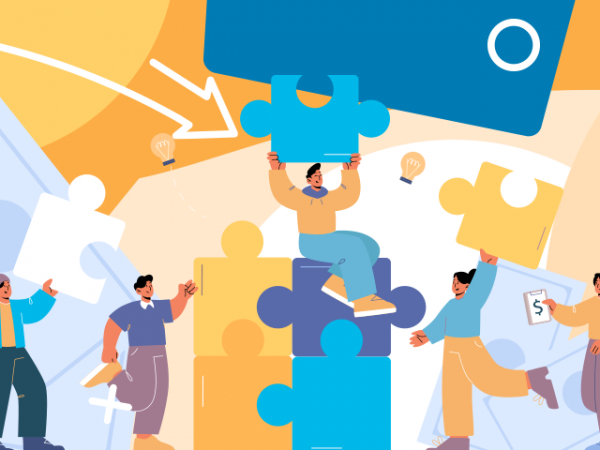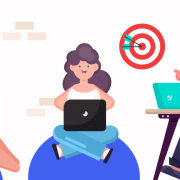As the COVID-19 pandemic locked us all into our homes, it has become more challenging for organizations to maintain routine communication and processes. Here at FarShore, remote work is nothing new. We are spread across three continents, so relying on online communication tools has never been an obstacle to our success and productivity. However, moving into our home offices brought a potential risk of being deprived of the things that make our work hours so great: our morning rituals, having lunch together, socializing during breaks, frequent outbursts of loud laughter… Suddenly, we found ourselves distant from each other, without the opportunity to have a casual conversation in the kitchen, unable to laugh together or comfort each other during these uncertain times. Fortunately, we live in an age when various communication platforms exist. With a little creativity, we have figured out how to transition our usual in-person interactions to the virtual environment and retain our special team spirit. So here are few examples of what helped us keep a sense of togetherness during the lockdown.
INFORMAL CHAT GROUPS
Chat groups are a great solution for quick and effective communication. Chats do not require the same level of involvement as calls and video meetings do, nor the formal language and structure as emails. Therefore, they are perfect for maintaining casual communication during the day. We use Skype chats as our number one tool for being connected to our global teams and for communicating internally. In addition to formal chat groups where our projects are discussed, we also have those for informal purposes. All of our unforgettable moments are written there: success celebrations, after-work drink arrangements, group photos, inside jokes, and much more. Although informal chats were introduced here long ago, their importance has stood out during the remote period. In these stressful circumstances, they brought a sense of familiarity into our workday.
VIRTUAL COFFEE BREAKS
As already stated, chats are great, but they are not a good enough substitute for live socializing. Of course, you can always steal some time from a daily team meeting to have a little informal conversation. However, that can unnecessarily prolong the meeting and cause dissatisfaction among colleagues who are having a busy day. To prevent such situations and respect everyone’s time, it is good to leave informal conversations for a special meeting -intended exclusively for that.During the lock down, there was an increased risk for employees to feel lonely and isolated. Providing them a virtual place where they can laugh together, vent their worries, or just drink coffee with their dear colleagues can be helpful. Also, such informal meetings are a good opportunity for new employees (being on boarded remotely) to get to know their teammates and feel more included in everyday interactions.Because of that, FarShore introduced Virtual Morning Coffee Sessions twice a week. It was not mandatory for anyone to participate; those who had time and desire could join a video call just to catch up on what’s going on in everyone’s lives. Every Tuesday and Thursday we were pleased to see each other’s faces, hear each other’s voices, and spend some time just being together.
REMOTE TEAM BUILDING ACTIVITIES
Having occasional team building activities is a great way for team members to meet each other on a whole new level. Teambuilding activities should be fun and held in a way that everyone is comfortable participating in them. Here at FarShore, we usually have two types of team building activities: competitive games and “get to know you” activities. Competitive games usually refer to activities in which you need to divide employees into small teams competing in achieving the same goal. Making random teams can deepen connections between employees from different departments that usually do not have the chance to work closely together. FarShore has a traditional quiz league that has been going on for years. We did not allow quarantine to prevent us from further holding our quizzes. All we needed was a streaming platform, a communication tool, and the “creativity superpower” of our PM Team Lead. Taking only 20 minutes a week to participate was an opportunity for everyone to take a break from everyday tasks, learn something new, and have a good time. The second type of activity that we practice is different variations of “get to know you” games. The idea of those activities is creating bonds on a private, not just on a professional level. For example, this can take the form of participants answering some intriguing questions or sharing some photos on a specific topic related to their life. In such activities, it is important to give the employees the freedom to control how much they are willing to reveal about themselves. During the lockdown, as we all worked from our home offices at the same time, we came up with the idea that we could peek at each other’s homes. Employees got a list of tasks to photograph in their home offices. Some were quite simple (selfie in the home office, lunch in the home office), while some required a little bit of imagination and creativity (weapon to fight Corona, an interesting detail from the home office). All photos were gathered into small galleries for each employee and we reviewed them together in one of our informal chat groups. Just seeing how everyone is working in their “natural habitats” was quite interesting, not to mention how some of our colleagues really stood out with their creativity, sense of humor, and surprising details. Furthermore, it is possible to add a competitive touch to a “get to know you” game. In this example, people could guess which pictures belong to whom or vote for the best “home office dress code” through a poll.
CONCLUSION
Although work from home has many benefits, it can also represent a significant challenge for maintaining the common office culture and employees’ wellbeing. It can cause blurred lines between working hours and free time. This is especially evident in times of social isolation when people rarely have after-work plans that involve leaving their workspace. Also, when everyone is working remotely, the regular rhythm of the workday (for instance, time for group lunch or leaving the office at the end of the day) is lost. Therefore, some tend to bury themselves in work, postponing their lunch breaks, and remaining available long after their work hours ended. All that can lead to persistent fatigue or even burnout among employees. Staying connected can contribute to the prevention of such a scenario. Engaging your employees in activities where they can pause from work and spend some relaxing time together could help them unwind from everyday stress. Those activities serve as a reminder that it is ok to have a break when working remotely as well as sending the message the company is taking care of everyone’s wellbeing. Preserving a sense of togetherness is of most significance in these challenging times











